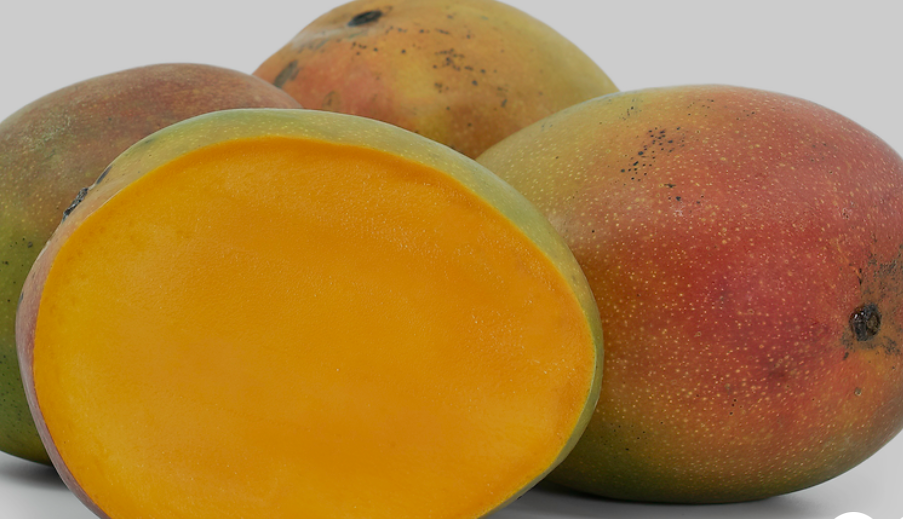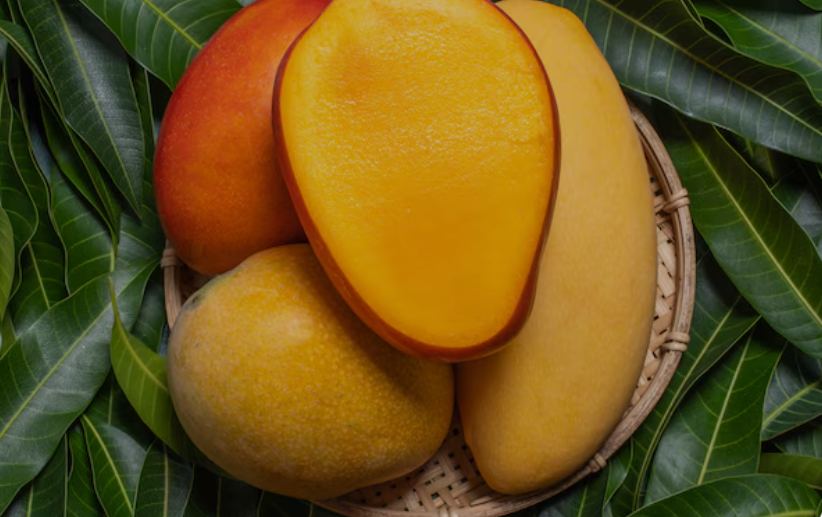
Mangoes with tiny or no seeds, often called seedless mangoes, are highly prized for their convenience and smooth eating experience. Unlike traditional mango varieties with large central pits, these mangoes allow you to enjoy nearly all of the flesh without the hassle of removing a large seed. Their tender, fiber-free flesh makes them ideal for fresh consumption, smoothies, desserts, and purees.
One of the most popular seedless mangoes is the Ataulfo, also known as the Honey or Champagne mango. It is small, golden, and buttery, with almost no seed, offering a smooth texture and rich sweetness. Its seedless nature makes it extremely convenient for snacking and culinary use. Similarly, the Alphonso mango, often called the “King of Mangoes,” has a very small seed, allowing for nearly all of its aromatic, creamy flesh to be enjoyed.
Asian varieties such as Nam Doc Mai from Thailand and Carabao from the Philippines also feature tiny seeds. Nam Doc Mai has long, slender fruits with ultra-smooth flesh that is almost entirely edible, while Carabao mangoes are extremely sweet, fiber-free, and prized for desserts and fresh eating. Their minimal seeds make them convenient for slicing and blending.
Other globally grown mangoes, like Kent, Keitt, and Irwin, also have small seeds relative to their size. Kent mangoes are large and juicy with fiberless flesh, Keitt mangoes are sweet and tender, and Irwin mangoes are aromatic with soft flesh. In all these varieties, the seeds are small enough that most of the flesh can be enjoyed without much waste.
Seedless or nearly seedless mangoes are not only convenient but also versatile in the kitchen. Because there is no large pit to work around, they can be easily diced for salads, blended into smoothies, or pureed for sauces and desserts. This makes them especially popular for recipes that require large amounts of mango flesh without stringy fibers or large seeds.

Mangoes With Tiny or No Seeds
Sindhu
The Sindhu mango is a groundbreaking hybrid variety developed in 1992 at the Konkan Krishi Vidyapith in Dapoli, India, through a cross between the Ratna and Alphonso mangoes. This Indian-origin cultivar is celebrated as one of the world’s first truly seedless mangoes, featuring an exceptionally tiny and underdeveloped seed that is often negligible.
The fruits are small to medium-sized, oval to round in shape, with smooth yellow skin that ripens to a golden hue, and they typically weigh around 200-300 grams.
Mahachanok
Originating from Thailand, the Mahachanok mango—also known as Maha Chanok—is a premium hybrid cultivar prized for its compact tree growth and early to mid-season harvest, making it suitable for home gardens and container cultivation in subtropical climates like Florida. The oblong, medium-sized fruits feature a yellow to orange exterior when ripe, encasing smooth, fiberless flesh that surrounds a notably thin and small seed.
Goa Mankurad
The Goa Mankurad, a beloved staple of Goan summers in India, hails from the coastal state of Goa and is cherished for its petite size and robust flavor that captures the essence of traditional desi mangoes. These small fruits, weighing 200-250 grams, boast uniform yellow skin and abundant, rich pulp around a small, flat seed that minimizes waste and maximizes edibility. As a seasonal delight available from April to June, Mankurad is often enjoyed fresh or in local delicacies.
Dudhiya Malda
Dudhiya Malda, originating from the Malda region in Bihar, India, and also revered in Nepal’s Saptari and Siraha districts, earns its name—”milky Malda”—from its creamy, milky yellow pulp that defines this “King of Mangoes.” The medium-sized fruits feature thin, smooth skin and completely fiberless flesh encircling a characteristically small seed. Harvested in the summer months, Dudhiya Malda’s vigorous, medium-sized tree produces reliable crops. It is a sought-after variety for those craving an aromatic, low-fiber indulgence.
Little Gem
Little Gem is a compact, Florida-bred mango from the Zill breeding program, developed as a seedling of the Julie variety, ideal for small spaces and urban gardens due to its dwarf growth habit reaching just 8-10 feet tall. The tiny, round fruits—about 3 inches in diameter—ripen late in the season with golden-yellow skin and orange flesh surrounding a small, monoembryonic seed that ensures a high proportion of edible content.
Flavor-wise, it offers a rich, sweet spiciness with medium-bodied Indian and West Indian influences, reminiscent of Jakarta or Phoenix mangoes, complete with tropical notes and outstanding disease resistance. This variety bears heavily in July.
Keitt
The Keitt mango traces its roots to Florida in the early 1940s, though it’s widely grown in Australia, Brazil, and South Africa, known for its late-season reliability and massive yields in warm climates. These large, ovoid fruits—often exceeding 2 pounds and up to 5 pounds—retain a green skin even when ripe, with juicy, low-fiber yellow flesh around a thin seed that boasts an excellent flesh-to-seed ratio, often described as “family-sized” for sharing.
The flavor is mild and sweet with subtle citrus hints, it can be used for fresh eating, salsas, or drying without the stringiness of other varieties. Keitt’s vigorous, spreading tree thrives in humid conditions, producing abundant crops from August to October.
Glenn
Developed in Florida as a Haden x Kensington Pride hybrid, the Glenn mango is a mid-to-late season favorite in subtropical regions like Italy and the US, grown on medium-sized trees with rounded canopies for easy harvesting. The medium-to-large fruits display red-blushed skin and creamy, fiberless orange flesh that effortlessly separates from its signature paper-thin seed, ensuring a seamless eating experience with virtually no waste.
Its flavor is sweetly mild with peachy undertones and a pleasant, aromatic scent when ripe, earning top ratings for quality and vigor. Glenn’s disease tolerance and juicy texture make it a top choice for fresh consumption or smoothies, ripening reliably in July-August.
Xoai Hat Lep
Xoai Hat Lep, or “flat-seed mango,” is a Vietnamese variety primarily from An Giang Province in the Mekong Delta, celebrated for its unique shape and regional culinary role in both green and ripe forms. The medium-sized fruits are slightly elongated with a curved tail, dark green skin that turns yellowish when mature, and abundant pulp hugging a notably flat seed that allows for more flesh per fruit.
Flavor profiles lean tangy-sweet and refreshing, with a crisp texture when unripe for salads and a softer, juicy sweetness when ripe, often enhanced by local spices. This prolific bearer thrives in tropical lowlands, offering a cultural staple with minimal seed hassle during the peak summer harvest.
Alphonso
The Alphonso mango, originating from the Ratnagiri and Devgad districts of Maharashtra, India, is dubbed the “King of Mangoes” for its elite status, with fruits available from February to May on semi-dwarf trees suited to coastal climates. Medium-sized and oval, the fruits ripen to a greenish-yellow skin with deep orange, fiberless pulp encasing a thin, flat, solitary seed in a woody stone, providing a high edible yield of about 5-10 ounces per fruit.
Its flavor is intensely sweet and creamy with nutty, saffron-like aromas and no tartness, making it ideal for purees, ice creams, or fresh slices. Alphonso’s smooth texture and GI-protected heritage ensure it’s a luxurious, low-fiber treat worldwide.
Carrie
Carrie, a Florida native from a Sophie Fry seedling discovered in Boynton Beach in the 1950s, is a compact, early-season mango on small trees perfect for home orchards in humid subtropics. The medium fruits turn golden-yellow when ripe on the tree, revealing fiberless, spicy-sweet flesh around a thin seed that yields an excellent flesh ratio, though over-ripening can intensify its resinous notes.
Flavor ranges from tropical peach to a bold, musky spice that divides palates but delights fans of complex profiles. Ripening in June-July, Carrie’s reliability and low fiber make it a go-to for effortless snacking or culinary uses.
Rapoza
Rapoza, a high-quality Hawaiian hybrid from the University of Hawaii’s breeding program, is a late-season standout grown on compact trees resistant to diseases, ideal for Pacific and Florida climates. The large, 26-30 ounce fruits feature red-blushed skin and deep orange-yellow, juicy, fiberless flesh surrounding a monoembryonic seed, delivering a superb pulp proportion.
Its flavor is classic and delicious—light to medium-bodied with stone fruit notes and a mild, citrusy intensity akin to Irwin—aromatic and excellent for fresh eating. Mid-to-early late harvest in August-September ensures abundant, premium yields.
Smith (Hawaii)
The Smith mango, a Hawaiian selection likely from Florida-Hawaii crosses, is a medium-sized, vigorous variety prized for its classic appeal in island orchards, with fruits ripening mid-season on spreading trees. Weighing around 550 grams, the orange-fleshed orbs blush crimson and offer fiberless, deep yellow pulp with a paper-thin seed for maximal edibility and smooth texture.
Flavor mirrors favorites like Bailey’s Marvel—sweet, balanced, and stone-fruited with moderate yield but heavy crops in good years. Smith’s anthracnose resistance and versatility make it a reliable choice for tropical fresh markets.
Gouveia
Gouveia, a late-season Florida cultivar descended from the Pirie mango, grows on medium trees with good bacterial spot resistance, suited to dry subtropical areas like Hawaii and the US. The medium, ovoid-ovate fruits display a striking blood-red blush over yellow skin, with firm, cadmium-orange flesh around a small, slender monoembryonic seed and very little fiber for easy pitting.
Its classic flavor is mildly tart yet creamy, with a pleasant aroma that shines in fresh or processed forms. Harvested in August-September, Gouveia’s attractive appearance and quality earn it acclaim among connoisseurs.
Nam Doc Mai
Nam Doc Mai, a slender Thai icon from the central plains, is cultivated worldwide including the UAE, on vigorous yet manageable trees that fruit early to mid-season in warm zones. The long, 12-20 ounce fruits have golden skin with green spots and a prominent beak, enclosing floral, honey-sweet, creamy flesh around a notably thin, polyembryonic seed that maximizes meaty pulp.
Its intoxicating aroma and low fiber deliver a dessert-like experience, robust yet balanced, perfect for slicing or export. Varieties like Sia Tong add vigor, but all share this seedless-like efficiency for year-round appeal.